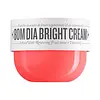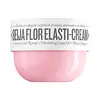What's inside
What's inside
 Key Ingredients
Key Ingredients

 Benefits
Benefits

 Concerns
Concerns

 Ingredients Side-by-side
Ingredients Side-by-side

Water
Skin ConditioningMethyl Glucose Sesquistearate
EmollientDodecane
PerfumingCaprylic/Capric Triglyceride
MaskingCetearyl Alcohol
EmollientParfum
MaskingPhenyl Trimethicone
Skin ConditioningCetyl Alcohol
EmollientGlycerin
HumectantCocos Nucifera Oil
MaskingSpondias Mombin Pulp Extract
Skin ConditioningMusa Sapientum Pulp Extract
Skin ConditioningMangifera Indica Pulp Extract
Skin ConditioningCarica Papaya Fruit Extract
Skin ConditioningTheobroma Grandiflorum Seed Butter
Skin ConditioningEuterpe Oleracea Fruit Oil
Skin ConditioningSalix Alba Bark Extract
AstringentGardenia Taitensis Flower Extract
Skin ConditioningTetrahexyldecyl Ascorbate
AntioxidantTocopherol
AntioxidantGlyceryl Caprylate
EmollientEthylhexylglycerin
Skin ConditioningSorbitan Isostearate
EmulsifyingEthylene Brassylate
MaskingXanthan Gum
EmulsifyingGlyceryl Stearate Citrate
EmollientHydroxyethyl Acrylate/Sodium Acryloyldimethyl Taurate Copolymer
Emulsion StabilisingSodium Stearoyl Glutamate
CleansingPhenoxyethanol
PreservativeBenzyl Alcohol
PerfumingPotassium Sorbate
PreservativeCitric Acid
BufferingSorbic Acid
PreservativeCI 17200
Cosmetic ColorantCI 19140
Cosmetic ColorantWater, Methyl Glucose Sesquistearate, Dodecane, Caprylic/Capric Triglyceride, Cetearyl Alcohol, Parfum, Phenyl Trimethicone, Cetyl Alcohol, Glycerin, Cocos Nucifera Oil, Spondias Mombin Pulp Extract, Musa Sapientum Pulp Extract, Mangifera Indica Pulp Extract, Carica Papaya Fruit Extract, Theobroma Grandiflorum Seed Butter, Euterpe Oleracea Fruit Oil, Salix Alba Bark Extract, Gardenia Taitensis Flower Extract, Tetrahexyldecyl Ascorbate, Tocopherol, Glyceryl Caprylate, Ethylhexylglycerin, Sorbitan Isostearate, Ethylene Brassylate, Xanthan Gum, Glyceryl Stearate Citrate, Hydroxyethyl Acrylate/Sodium Acryloyldimethyl Taurate Copolymer, Sodium Stearoyl Glutamate, Phenoxyethanol, Benzyl Alcohol, Potassium Sorbate, Citric Acid, Sorbic Acid, CI 17200, CI 19140
Water
Skin ConditioningCetearyl Alcohol
EmollientParfum
MaskingCaprylic/Capric Triglyceride
MaskingIsopentyldiol
HumectantGlyceryl Stearate
EmollientC13-16 Isoparaffin
SolventGlycerin
HumectantPyrus Malus Fruit Extract
Skin ConditioningCetyl Alcohol
EmollientCocos Nucifera Oil
MaskingCaryodendron Orinocense Seed Oil
EmollientButyrospermum Parkii Butter
Skin ConditioningBehenyl Alcohol
EmollientSqualane
EmollientCollagen Amino Acids
MoisturisingTheobroma Grandiflorum Seed Butter
Skin ConditioningCopaifera Officinalis Resin
MaskingAstrocaryum Vulgare Kernel Oil
Skin ConditioningAstrocaryum Murumuru Seed Butter
EmollientDaucus Carota Sativa Root Extract
Skin ConditioningTocopherol
AntioxidantOryza Sativa Bran Extract
Skin ConditioningRosmarinus Officinalis Leaf Extract
AntimicrobialHelianthus Annuus Seed Oil
EmollientHelianthus Annuus Extract
EmollientEthylhexylglycerin
Skin ConditioningPentylene Glycol
Skin ConditioningHeptyl Undecylenate
EmollientPotassium Cetyl Phosphate
EmulsifyingTetrasodium Glutamate Diacetate
Xanthan Gum
EmulsifyingCitric Acid
BufferingSodium Hydroxide
BufferingPhenoxyethanol
PreservativeMica
Cosmetic ColorantAlpha-Isomethyl Ionone
PerfumingBenzyl Salicylate
PerfumingCI 77891
Cosmetic ColorantWater, Cetearyl Alcohol, Parfum, Caprylic/Capric Triglyceride, Isopentyldiol, Glyceryl Stearate, C13-16 Isoparaffin, Glycerin, Pyrus Malus Fruit Extract, Cetyl Alcohol, Cocos Nucifera Oil, Caryodendron Orinocense Seed Oil, Butyrospermum Parkii Butter, Behenyl Alcohol, Squalane, Collagen Amino Acids, Theobroma Grandiflorum Seed Butter, Copaifera Officinalis Resin, Astrocaryum Vulgare Kernel Oil, Astrocaryum Murumuru Seed Butter, Daucus Carota Sativa Root Extract, Tocopherol, Oryza Sativa Bran Extract, Rosmarinus Officinalis Leaf Extract, Helianthus Annuus Seed Oil, Helianthus Annuus Extract, Ethylhexylglycerin, Pentylene Glycol, Heptyl Undecylenate, Potassium Cetyl Phosphate, Tetrasodium Glutamate Diacetate, Xanthan Gum, Citric Acid, Sodium Hydroxide, Phenoxyethanol, Mica, Alpha-Isomethyl Ionone, Benzyl Salicylate, CI 77891
 Reviews
Reviews

Ingredients Explained
These ingredients are found in both products.
Ingredients higher up in an ingredient list are typically present in a larger amount.
This ingredient is an emollient, solvent, and texture enhancer. It is considered a skin-softener by helping the skin prevent moisture loss.
It helps thicken a product's formula and makes it easier to spread by dissolving clumping compounds.
Caprylic Triglyceride is made by combining glycerin with coconut oil, forming a clear liquid.
While there is an assumption Caprylic Triglyceride can clog pores due to it being derived from coconut oil, there is no research supporting this.
Learn more about Caprylic/Capric TriglycerideCetearyl alcohol is a mixture of two fatty alcohols: cetyl alcohol and stearyl alcohol. It is mainly used as an emulsifier. Emulsifiers help prevent the separation of oils and products. Due to its composition, it can also be used to thicken a product or help create foam.
Cetearyl alcohol is an emollient. Emollients help soothe and hydrate the skin by trapping moisture.
Studies show Cetearyl alcohol is non-toxic and non-irritating. The FDA allows products labeled "alcohol-free" to have fatty alcohols.
This ingredient is usually derived from plant oils such as palm, vegetable, or coconut oils. There is debate on whether this ingredient will cause acne.
Due to the fatty acid base, this ingredient may not be Malassezia folliculitis safe.
Learn more about Cetearyl AlcoholCetyl Alcohol is a fatty alcohol. Fatty Alcohols are most often used as an emollient or to thicken a product.
Its main roles are:
Though it has "alcohol" in the name, it is not related to denatured alcohol or ethyl alcohol.
The FDA allows products labeled "alcohol-free" to have fatty alcohols.
Learn more about Cetyl AlcoholCitric Acid is an alpha hydroxy acid (AHA) naturally found in citrus fruits like oranges, lemons, and limes.
Like other AHAs, citric acid can exfoliate skin by breaking down the bonds that hold dead skin cells together. This helps reveal smoother and brighter skin underneath.
However, this exfoliating effect only happens at high concentrations (20%) which can be hard to find in cosmetic products.
Due to this, citric acid is usually included in small amounts as a pH adjuster. This helps keep products slightly more acidic and compatible with skin's natural pH.
In skincare formulas, citric acid can:
While it can provide some skin benefits, research shows lactic acid and glycolic acid are generally more effective and less irritating exfoliants.
Most citric acid used in skincare today is made by fermenting sugars (usually from molasses). This synthetic version is identical to the natural citrus form but easier to stabilize and use in formulations.
Read more about some other popular AHA's here:
Learn more about Citric AcidCocos Nucifera Oil is obtained from the kernels of the coconut fruit. In other words, this is coconut oil.
Coconut Oil is rich in fatty acids with lauric acid making up the majority of these. It also contains linoleic acid. Due to this high fatty acid content, coconut oil helps trap moisture and soften skin.
Despite being antibacterial, coconut oil may not be great for acne-prone skin. It is comedogenic and may clog pores. This ingredient may not be safe for malassezia or fungal acne.
Note: Coconut Oil should not replace your sunscreen for UV protection. Studies show it only blocks about 20% of UV.
This oil is non-volatile and has a light scent.
The term 'fragrance' is not regulated in many countries. In many cases, it is up to the brand to define this term. For instance, many brands choose to label themselves as "fragrance-free" because they are not using synthetic fragrances. However, their products may still contain ingredients such as essential oils that are considered a fragrance.
Learn more about Cocos Nucifera OilEthylhexylglycerin (we can't pronounce this either) is commonly used as a preservative and skin softener. It is derived from glyceryl.
You might see Ethylhexylglycerin often paired with other preservatives such as phenoxyethanol. Ethylhexylglycerin has been found to increase the effectiveness of these other preservatives.
Glycerin is already naturally found in your skin. It helps moisturize and protect your skin.
A study from 2016 found glycerin to be more effective as a humectant than AHAs and hyaluronic acid.
As a humectant, it helps the skin stay hydrated by pulling moisture to your skin. The low molecular weight of glycerin allows it to pull moisture into the deeper layers of your skin.
Hydrated skin improves your skin barrier; Your skin barrier helps protect against irritants and bacteria.
Glycerin has also been found to have antimicrobial and antiviral properties. Due to these properties, glycerin is often used in wound and burn treatments.
In cosmetics, glycerin is usually derived from plants such as soybean or palm. However, it can also be sourced from animals, such as tallow or animal fat.
This ingredient is organic, colorless, odorless, and non-toxic.
Glycerin is the name for this ingredient in American English. British English uses Glycerol/Glycerine.
Learn more about GlycerinParfum is a catch-all term for an ingredient or more that is used to give a scent to products.
Also called "fragrance", this ingredient can be a blend of hundreds of chemicals or plant oils. This means every product with "fragrance" or "parfum" in the ingredients list is a different mixture.
For instance, Habanolide is a proprietary trade name for a specific aroma chemical. When used as a fragrance ingredient in cosmetics, most aroma chemicals fall under the broad labeling category of “FRAGRANCE” or “PARFUM” according to EU and US regulations.
The term 'parfum' or 'fragrance' is not regulated in many countries. In many cases, it is up to the brand to define this term.
For instance, many brands choose to label themselves as "fragrance-free" because they are not using synthetic fragrances. However, their products may still contain ingredients such as essential oils that are considered a fragrance by INCI standards.
One example is Calendula flower extract. Calendula is an essential oil that still imparts a scent or 'fragrance'.
Depending on the blend, the ingredients in the mixture can cause allergies and sensitivities on the skin. Some ingredients that are known EU allergens include linalool and citronellol.
Parfum can also be used to mask or cover an unpleasant scent.
The bottom line is: not all fragrances/parfum/ingredients are created equally. If you are worried about fragrances, we recommend taking a closer look at an ingredient. And of course, we always recommend speaking with a professional.
Learn more about ParfumPhenoxyethanol is a preservative that has germicide, antimicrobial, and aromatic properties. Studies show that phenoxyethanol can prevent microbial growth. By itself, it has a scent that is similar to that of a rose.
It's often used in formulations along with Caprylyl Glycol to preserve the shelf life of products.
Theobroma Grandiflorum Seed Butter isn't fungal acne safe.
Tocopherol (also known as Vitamin E) is a common antioxidant used to help protect the skin from free-radicals and strengthen the skin barrier. It's also fat soluble - this means our skin is great at absorbing it.
Vitamin E also helps keep your natural skin lipids healthy. Your lipid skin barrier naturally consists of lipids, ceramides, and fatty acids. Vitamin E offers extra protection for your skin’s lipid barrier, keeping your skin healthy and nourished.
Another benefit is a bit of UV protection. Vitamin E helps reduce the damage caused by UVB rays. (It should not replace your sunscreen). Combining it with Vitamin C can decrease sunburned cells and hyperpigmentation after UV exposure.
You might have noticed Vitamin E + C often paired together. This is because it is great at stabilizing Vitamin C. Using the two together helps increase the effectiveness of both ingredients.
There are often claims that Vitamin E can reduce/prevent scarring, but these claims haven't been confirmed by scientific research.
Learn more about TocopherolWater. It's the most common cosmetic ingredient of all. You'll usually see it at the top of ingredient lists, meaning that it makes up the largest part of the product.
So why is it so popular? Water most often acts as a solvent - this means that it helps dissolve other ingredients into the formulation.
You'll also recognize water as that liquid we all need to stay alive. If you see this, drink a glass of water. Stay hydrated!
Learn more about WaterXanthan gum is used as a stabilizer and thickener within cosmetic products. It helps give products a sticky, thick feeling - preventing them from being too runny.
On the technical side of things, xanthan gum is a polysaccharide - a combination consisting of multiple sugar molecules bonded together.
Xanthan gum is a pretty common and great ingredient. It is a natural, non-toxic, non-irritating ingredient that is also commonly used in food products.
Learn more about Xanthan Gum